|
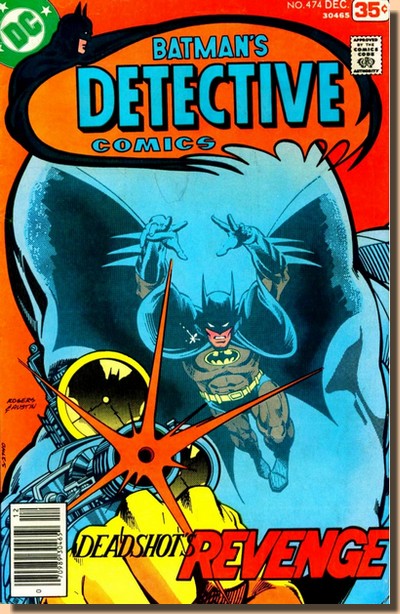 |
|
SPOTLIGHT
ON
DETECTIVE COMICS
#474
DECEMBER 1977
"The
Deadshot Ricochet"
(17 pages)
Cover pencils - Marshall
Rogers
Cover inks - Terry Austin
Cover colouring - Tatjana Wood
Story - Steve
Englehart
Art - Marshall Rogers
Inks - Terry Austin
Colours - Jerry Serpe
Lettering - Ben Oda
Editor - Julius Schwartz
|
|
| |
PLOT SUMMARY
Having taken the Penguin out
of circulation once again (in the preceding Detective
Comics #473), Batman and Robin return to the Batcave
only to find that the younger member of the Dynamic Duo
is summoned by an emergency call to the Teen Titans.
Meanwhile, at Gotham Prison,
the Penguin is put into a cell next to Floyd Lawton, who
tried to take down Batman as Deadshot and has been
serving time ever since. Now, however, fate has finally
offered him an opening as the Penguin brags loudly about
his special laser monocle - which of course he has every
intention of using to escape from prison. Seizing the
lucky moment, Deadshot snatches the monocle from his cell
neighbour and immediately sets it to use for his own
escape...
|
| |
| That
very same evening, the Darknight
Detective pays an ad hoc visit to the
Tobacconists' Club to confront Gotham
City councilman Rupert Thorne, whom he
criticizes heavily for the recent issue
of a cease and desist against Batman.
Warning Thorne that from now on the two
of them will play things the Batman's
way, he leaves a fairly shaken councilman
behind - whose confidence immediately
takes another beating as he seems to see
a haunting vision of Hugo Strange (whom
he had ordered and seen killed),
appearing like a ghost, right there in
his office... The next day Bruce
Wayne meets up with Silver St Cloud (a
Gotham City socialite who delights in
hosting parties for the rich and
influential - and Bruce Wayne's current
love interest) at the Gotham Convention
Center, where her company is hosting the
current event. They both run into
Commissioner Gordon who informs Bruce
Wayne of the recent escape of Deadshot.
Upon hearing
this news, Batman goes back in his mind
to the first encounter he had with
Deadshot a few years back, and he
reflects upon the thin line which
separates Batman the crimefighting
vigilante from Deadshot the crimefighting
criminal, and how uncomfortably much they
have in common.
As Bruce
Wayne takes Silver out for lunch, her
constant flow of questions makes him
think that she might suspect the truth -
that Bruce Wayne and Batman are one and
the same person...
As night
falls over Gotham City, the Darknight
Detective is once again out on patrol,
and it is not long before he crosses the
path of Deadshot - who has changed his
appearance but not his modus operandi.
|
|
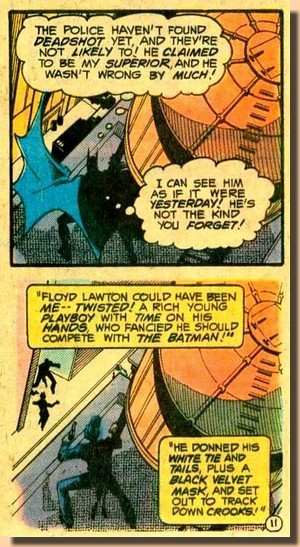
|
|
|
| |
| Following a fight
across the rooftops of Gotham City, they
eventually find themselves at the Convention
Center where they battle it out on one of the
exhibits - a giant typewriter. |
| |

|
|
Batman
finally manages to trap
Deadshot behind the
over-sized carriage
return, and deadshot once
again is forced to
acknowledge defeat
against the Darknight
Detective. But
as Batman looks up, he
sees Silver St Cloud
staring back at him, and
he realizes that deep
down inside her she
recognizes him and thus
knows - that Batman is
Bruce Wayne... DEADSHOT
- THE REVAMP OF A
C LIST GOLDEN AGE VILLAIN
Although
quintessentially a done
in one Batman story,
"The Deadly
Ricochet" actually
forms part of an eight
issue overall story arc
which ran from Detective
Comics #469 up to
issue #476 (later to be
published in collected
form and retroactively
titled Batman:
Strange Apparitions).
|
|
|
|
| |
| For
this particular issue, Englehart dug up and
revived a villain whose last - and only -
appearance in the Batman Universe had taken place
27 years ago, in Batman #59: Deadshot. |
| |
|
| This required some
updating for virtually all of the
readership, and Englehart used a number
of flashback scenes to fill readers in on
who exactly Floyd Lawton a.k.a. Deadshot
was and what had happened back in Batman
#59, whilst his appearance was
changed radically by penciller Marshall
Rogers (after giving the readers glimpses
of what the villian looked like before):
Deadshot is no longer the debonair Fred
Astaire-like gent with airs; he now
sports a tight red outfit and a mask
which completely covers (and indeed
hides) his face, and Lawton has also
upgraded his weaponry to a high precision
booster gun which the sniper straps to
his wrist. Whilst not making it
to the front row of Batman or DC
villains, Deadshot would now be around
every now and then and retain the outfit
introduced in this issue of Detective
Comics.
|
|
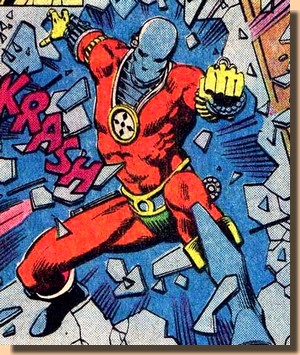
|
|
|
| |
ORIGIN
"WHEREAS
I, DEADSHOT, have
proved my ability as a crime fighter beyond any
reasonable doubt; whereas I have also proved in direct
competition to be more efficient and reliable than BATMAN,
I hereby petition the people of Gotham City to recognize
me officially as --
"THE MAN WHO REPLACED BATMAN!"
(Intro
from Batman #59)
"FLOYD LAWTON COULD HAVE
BEEN ME -- TWISTED!A
RICH YOUNG PLAYBOY
WITH TIME ON HIS HANDS,
WHO FANCIED HE SHOULD COMPETE WITH THE BATMAN!"
(from Detective Comics #474,
December 1977)
|
| |
First
appearing in Batman #59 (June/July
1950) millionaire Floyd Lawton, who
recently moved to Gotham City, is finally
ready to put his masterplan to work and
embark on a career as crimefighter after
perfecting his aim as a marksman for many
weeks and months.
Taking on the name
Deadshot and wearing a top coat with
white tie and black tails together with a
black velvet mask, Lawton successfully
takes down a number of crooks and
criminals and challenges Batman's
monopoly on crimefighting in Gotham City.
Meeting rather favourable reactions from
Gotham's officials, Lawton soon adjusts
his goal - rather than becoming equal to
Batman, he strives to actually - and
officially - replace Batman.
|
|
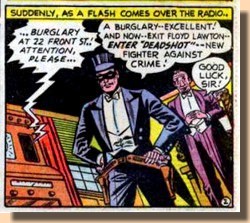
Batman #59
(June/July 1950)
|
|
|
| |
| The
competition from Deadshot is felt by Batman even
on a symbolic level when the Gotham night skies
all of a sudden are lit up not only by the
Batsignal but also by a Bullseye-Signal... However,
Batman soon discovers not only the secret
identity of Deadshot but also his true motives.
By driving Batman out of crimefighting, he
strives to fulfill his actual ultimate goal: to
become Gotham's greatest crime lord. His plan to
shoot Batman, however, misfires as the Darknight
Detective had previously and secretly altered the
aiming sights of Lawton's guns - helped even
further by the fact that Deadshot's ethics of not
shooting to kill make him miss Batman. It all
falls apart, and Deadshot is captured and sent to
prison.
|
| |
|
EVOLUTION
OF THE CHARACTER & APPEARANCES
Created by David Vern Reed
& Lew Schwartz (but officially attributed to
Bob Kane) and initially a debonair, almost Fred
Astaire-like gent with an air of sophistication
to his character, Floyd Lawton in his original
Deadshot attire may appear to be somewhat special
from today's perspective, but back in 1950 both
his special abilities (expert markmanship) as
well as his Park Lane (or Avenue, if you will)
appearance didn't really stand out at all in a
growing crowd of villains which, amongst other
things, had several members wearing top hats,
including the Penguin - who also happened to be
quite good in taking precise shots at the Dynamic
Duo.
Thus sharing the fate of many
Batman villains who made their first appearance
in the late 1940s and early 1950s, Deadshot was
thrown into the spotlight just once and then not
used again for a long time - the flavour of the
day was "give them a new villain every
issue" and the number of those who did get
to appear regularly and thus became long standing
classic villains (such as the Joker) was small
and hand-picked. When Deadshot was
locked away in a prison in Gotham City at the end
of 12-pages story "The Man who replaced
Batman!" in Batman #59, it
would prove to be a sentence of 27 years in real
time - before writer Steve Englehart reminded
readers of Floyd Lawton and let him escape his
prison cell in Detective Comics
#474 (December 1977).
|
|
| |
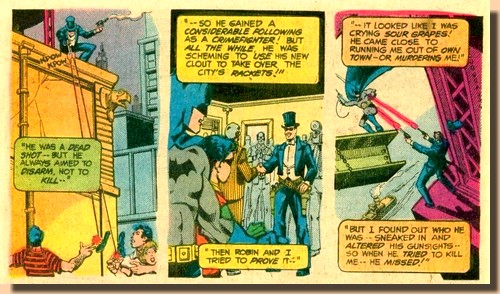
|
|
Whilst
acknowledging his origin and
original appearance through
flashbacks, penciller Marshall
Rogers' updated visuals of
Deadshot differed radically. But why bring
back this Golden Age villain in
the first place?
To a certain
extent, it had to do with an
editorial policy of acknowledging
and referencing the continuity of
the Batman Universe, but far more
important was the fact that the
character fitted really well into
the psychology of the Bronze Age
Darknight Detective persona and
character.
|
|
|
|
| |
| In terms of appearances,
however, Deadshot remains a a minor DC villain by all
standards. He resurfaced in a few issues of Batman
and Detective Comics in 1982 prior to being
featured mostly as a member of the Suicide Squad in the
late 1980s and early 1990s. He was back in the 2000s in
the Secret Six and as such has been integrated into DC's
"New 52". As a solo villain he has featured in
DC's live action TV shows Smallville as well as,
most recentlky, in Arrow. |
| |
REVIEW & ANALYSIS
Deadshot
generates a certain interest due to his closeness to the
Batman character himself: Just like Bruce Wayne, Floyd
Lawton is a wealthy man who, upon deciding to fight
crime, invested his time and money into a carefully laid
out plan in order to achieve that goal.
|
| Interestingly enough,
Lawton originally had no interest in
becoming a vigilante and actually tried
to work in cooperation with the police
force, making him far more compatible
with and generally more abiding by the
rule of law than is the case with Batman. However,
the ultimate goal makes for the
fundamental and important difference:
whereas the Batman's objective simply is
to fight crime, Deadshot's actions were
fairly soon dictated by his personal goal
of taking the place of Batman - which in
turn he would have used to become Gotham
City's kingpin of crime.
Deadshot thus
personifies e contrario, i.e. by
way of an inversion of argument, a
justification for the Batman: of course
the Darknight Detective operates outside
a strict rule of law and the state's
monopoly on force, but because he does so
only for the sake of or at least in the
interest of the general public and
without any motive of personal benefit
(other than, possibly, his own
psychological needs), his actions become
acceptable.
|
|
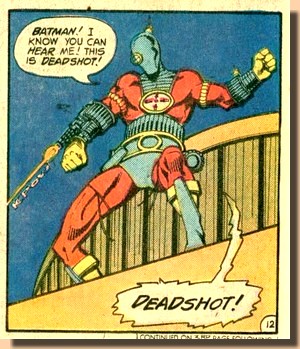
|
|
|
| |
| In other
words: Deadshot helps to define why Batman is not one of
the bad guys, and as such his revival by Englehart is an
interesting addition to the Batman Universe and provides
a key element in understanding the Darknight Detective's mythos.
As such, Detective Comics #474 is a classic late 1970s
Batman portrayal by Steve Englehart and Marshall Rogers,
featuring an interesting and well paced storyline with
stunningly atmospheric artwork. |
| |
FACTS
& FIGURES
Apart from an
obvious tilting of the hat by Englehart to early
adventures of Batman - where oversize props such
as the giant typewriter seemingly were the rule
rather than an exception - Detective Comics
#474 also contains several tongue in cheek cameo
references to past DC creators, such as the Fox
Gardens restaurant (clearly named after writer
Gardner Fox), Weisinger Office Suppliers (the
company who created the giant typewriter, named
for editor Mort Weisinger), and the Ellsworth
Building (named after Whitney Ellsworth).
|
| |
|
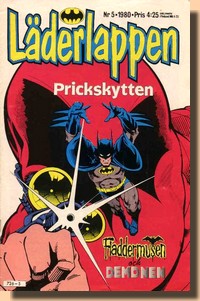 |
|
"The
Deadshot Ricochet" has been
reprinted on several occasions: in Shadow
of the Batman #3 (1986)
[re-coloured], The Greatest
Batman Stories Ever Told
Vol. 1 (DC, 1988), The
Greatest Batman Stories Ever Told
Vol. 1 (Warner Books, 1989), Batman:
Strange Apparitions (1999)
[re-coloured version from Shadow
of the Batman], and most
recently in Legends of the
Dark Knight: Marshall Rogers
(2011). Between 1978
and 1980, i.e. shortly after its
original publication, the story
was also translated and published
for different European and South
American markets:
- UK
(in Batman Pocketbook
#2 from Egmont/Methuen,
1978)
- Germany
(in Batman
Taschenbuch #2 from
Egmont/Ehapa, 1978)
- Italy
(in Batman #28
from Editore Cenisio,
1978)
- Brazil
(in Batman #13
from EBAL, 1978)
- Sweden
(in Läderlappen
#5 from Semic, 1980)
- Norway
(in Lynvingen #5
from Semic, 1980).
|
|
|
|
| |
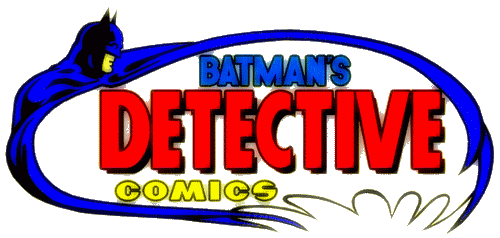
|
| |
|
| |
BATMAN and all
related elements are the property of DC
Comics, Inc. TM and © DC Comics, Inc., a
subsidiary of Time Warner Inc.
The illustrations presented here are
copyright material. Their reproduction for
the review purposes of this website is
considered fair use as set out by the
Copyright Act of 1976, 17
U.S.C. par. 107.
|
|